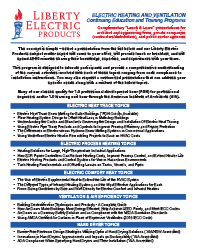Supporting Upstate New York, NY Metro, Long Island, New Jersey, and New England
Training and PDH Credits
We understand the global standards and their impact on your business - what you need to create, implement, and operate safe machines/job sites, profitable manufacturing operations, and comfortable buildings. With over 35 years of expertise worldwide, Liberty Electric Products & New England Electrical Sales are highly qualified to help engineers, architects, OEMs, integrators, and end users to understand the changing local and global standards.

Our team of experts provide on-site training on products, solutions, and applications in order to ensure that our customers are up to date on new products, new regulations, and new specifications. It is our goal be the go-to resource for our customers when it comes to technical requirements.
Liberty Electric Products & New England Electrical Sales are certified by the State of New York so that participation in events with us may earn you Professional Development Hours (PDH). PDH credits are educational units used to fulfill continuing education requirements for licensure, certification, or tenure for engineers, architects and other professionals in states that have a yearly requirement. Some of our training are also American Institute of Architects (AIA) accredited. Please let us know your requirements and we will let you know if a class is certified so you can receive a PDH or AIA certificate at the end of each class.
Nearly forty U.S. states now require continuing education for engineers to maintain licensure. Below is a table of the current requirements for the states that we cover.
| State | NY | CT | ME | MA | NH | RI | VT |
|---|---|---|---|---|---|---|---|
| Hours Required | 36 PDH every 3 years | No | 30 hours biennially | No | 30 hours biennially | No | 30 hours biennially |
| Board Approval Required for Classes to be Accepted. | Yes | NA | No | NA | No | NA | No |
| Other Requirements | Minimum of 18 PDH live courses are required | NA | 15 PDH may be carried forward | NA | 15 PDH may be carried forward | NA | Credit earned up to one year before the renewal date can be carried forward |
Some of the “Lunch and Learn” topics we currently offer:
PDH Approved Classes
- Electric Industrial Process Heaters - Proper Application and Specification (* PDH Credits Available)
- Electric Snow Melting - Products, Accessories, Controls and Application Knowledge (* PDH Credits Available)
- Electric Heating Cable Applications (* PDH Credits Available)
- Proper Application of Industrial and Chemical Tanks (* PDH Credits Available)
- Secondary Systems - Adding Value to Primary HVAC Systems with Supplemental Products to Increase Comfort and Improve Efficiencies
Heat Trace/Cable Products
- Electric Heat Trace Snow Melting for Safer Buildings (* PDH Credits Available)
- Floor Heating System Design to Offset Heat Loss in Multistory Buildings
- Understanding the Codes and Standards Governing the Design and Installation Of Electric Heat Tracing
- Using Electric Pipe Trace Products and Controls to Improve Process Efficiency and Freeze Protection
- The Differences in Electric versus Hydronic Snow Melting Systems in Commercial Applications
- Using Underfloor Electric Heat in Remodeling Projects to Save On HVAC Costs
Electric Heating Products
- Heating Solutions for Large, High-Temperature Industrial Applications
- How SCR Power Controllers Can Reduce Heating Costs, Improve Process Control, and Extend Heater Life
- Electric Heating Products and Control Systems for Use in Hazardous Environments
- Tank Heating Fundamentals and Offsetting Losses on Tanks, Vessels, and Pipes
- Superior Radiant Products Gas Fired Infrared Heating
Electric Comfort Heat Topics
- The Use of Electric Supplemental Heat to Extend the Life of the HVAC System
- The Different Types of Infrared Heating Systems and the Most Effective Applications for Each
- Room Sizing Guidelines by Size and Watt Density for Electric Comfort and Infrared Heaters
Ventilation Products & Air Efficiency Topics
- Building Destratification Techniques and Products - A Complete Guide
- How Air Doors Make Buildings More Energy Efficient, Help Achieve LEED Points, and Meet IECC Codes
- Air Doors as a Doorway Safety Solution and as Compliance with the USDA Sanitation Standards
- Using AMCA Certified Air Curtains in Place of Expensive Vestibules (2015 IECC Code)
- Main Entrance Air Curtains: Improving Energy Efficiency, Health, & Comfort
Hand Dryer Topics
- Barrier-Free Restroom Design Strategies Utilizing Optimal Hand Drying Solutions (*AIA/HSW Accredited)
- Innovations in Hand Dryers: Improvements and Impacts on Sustainability (*AIA Accredited)
- ADA Compliance When Specifying Hand Dryers and Their Installation (*AIA Accredited)
AEC Daily Free Online Education Classes:
AEC Daily is one of the largest sources of free continuing education courses for architects, engineers, contractors and other construction professionals. Below are our manufacturers that have free AIA and CEU classes.
Berner
Main Entrance Air Curtains: Improving Energy Efficiency, Health, & ComfortMain entrance air curtains are used by architects and engineers in commercial, institutional, and industrial settings to both improve energy efficiency and protect occupant comfort and well-being. This course reviews the research that led to air curtains being approved as an alternative to vestibules in ASHRAE 90.1-2019 and other building codes, as well as how air curtains on main entries contribute to sustainability goals around energy conservation, public health, and indoor air quality.
Marley
Contemporary Electric Heating BenefitsElectric heating systems have been in use for over a century, and in that period, they have significantly advanced in terms of their efficiency, cost effectiveness, safety, versatility, and appearance. Recently, electricity production itself has become more and more environmentally friendly and economically viable. This course explores how the wide range of contemporary electric heating options can efficiently and economically address virtually every heating need in every building type and thus capitalize on the steadily increasing benefits of electricity to create the most environmentally responsible and economically viable heating solutions.
Discreet Heat When and Where NeededHighly customizable electric heating solutions can provide either the main or supplemental heat for most indoor and outdoor spaces. Such solutions can harmonize beautifully with every architectural context and building configuration while addressing the full range of health, safety, comfort, and energy efficiency issues facing contemporary designers. This course examines the many supplemental electric heating solutions and devices available, their capabilities and configuration options, and how they can be customized to suit every unique architectural and engineering demand. It concludes with several illustrated cases.
World Dryer
The Wave of the Future: Sustainable Hand Dryer SolutionsGood restroom design includes regard for user experience, environmental impact, good hygiene, and cost over time─hand-drying fixtures are a necessary element of this design process. In this course, we review how new technologies can address the hygiene, dry speed, sound level, and accessibility concerns of a restroom project. We also discuss why it is vital to specify hand dryers with optimum energy and cost efficiency.
Infratech
Electric Infrared Heating Systems: A SustainableInfrared patio heaters are the best method of increasing comfort for outdoor entertaining areas of any size. There are many variables in creating ambient warmth, as both the effectiveness and the cost of heating an outdoor space greatly depend on the heating option that is selected and the way it is designed. This course looks at the outdoor heating options that are available with a focus on the types, color choices, mounting methods, and control options of electric infrared heaters, including a review of the steps that are required to select the best solution.
Step Warmfloor
Floor Warming, Primary Heating, Snow Melting & Roof Deicing with PTC HeatersWith a radiant heat system, the temperature profile associated with a forced-air system is switched around, and the entire floor becomes the radiator. The heat radiates from the floor, warming all of the objects in the room, and everything in the room gains a warm, comfortable feel to it. This course evaluates self-regulating polymer technology and the performance benefits of using PTC (positive temperature coefficient) heaters for energy-efficient floor warming, primary heating, snow melting, and roof deicing.


